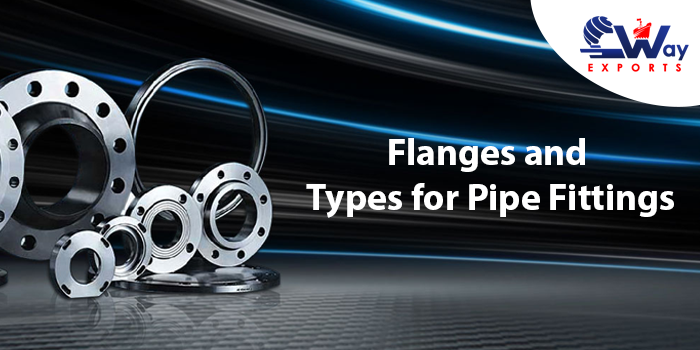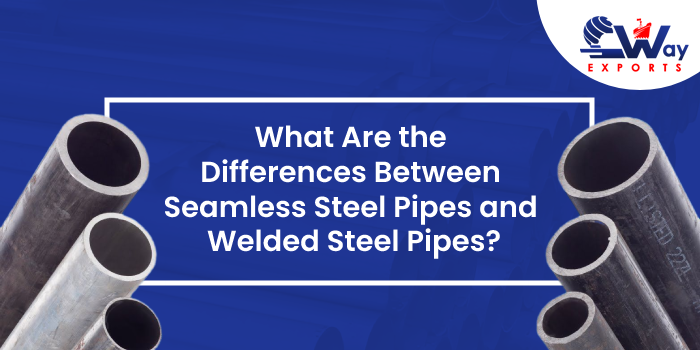Flanges and Types for Pipe Fittings
A flange is a mechanical joint system that offers a reliable way to connect pipes, valves, pumps, and other components to form a seal-proof piping system. A critical component of pipeline infrastructure, a flange is the second most common joining method used after welding.

Flanges – Components & Benefits:
A pipe flange, gasket and bolting system are three essential components of any flange connection. The pipe flange is attached to the pipe by welding or screwed fitting, and the joint is made by bolting the two pipe flanges with a gasket between them to enable a seal-proof connection.
The simple yet unique construction of flanges makes them robust yet an easy-to-assemble mechanical joint. They can fit in tight spaces, are easy to maintain, offer better flexibility, and provide better load distribution than hydraulic fittings in the piping industry.
Different Types of Flanges in Pipe Fittings:
Given flanges can be dismantled quickly and facilitate simple maintenance they are a perfect alternative to welding connections in the piping industry. Even better, flanges come in different designs to match the specific usage and joint strength needed in a piping system.
To ensure a reliable connection and long service life and optimal pricing, matching the ideal flange design becomes the key.
So in today’s blog let us take the first step in choosing the right flange type by identifying 7 key types of flanges that are commonly used in the piping industry:
1. Threaded Flanges:
Simplest of all the flanges, threaded flanges are connected by screwing the pipe onto the flange without the necessity of welding. In a few cases, welding may be executed in conjunction with the threaded connection to ensure a stronger connection.
The Threaded flanges are time-saving and economical flanges that are ideal for small diameter piping systems. They are also a mandatory choice for flanges in high explosive areas where welding is deemed dangerous.
2. Slip-on Flange:
As the name suggests, this type of flange slips over the connecting pipe as its bore size is slightly larger than the pipe’s diameter. The slip-on flange is connected to the flange using a two fillet weld executed one inside and another outside of the flange cavities. Owing to their availability in a large range of sizes, slip-on flanges are one of the most common types of flanges used in fluid pipelines.
3. Socket Weld Flanges:
Unlike threaded flange, the socket weld flanges are connected to the pipe with a single fillet weld on the outer side of the flange. The pipe is inserted into the socket leaving a little gap to ensure proper positioning of the pipe post the weld.
Socket weld flanges are ideal for small and high-pressure piping systems that carry non-corrosive liquids. The single weld also helps these flanges to manifest higher fatigue strength when compared to slip-on flanges.
4. Lap Joint Flange:
A lap joint flange is similar to a slip-on flange except for the radius at the intersection of the bore and the flange face to enable the stub end. The lap joint flange which can slide over the pipe is attached to the stub end with the help of bolts. The lap joint flange here can be made of lower quality material compared to the stub and hence lap joint flanges offer an economical mechanical connection reducing the overall cost of the piping system.
5. Blind Flange:
Blind flanges are utilized to seal a pipe, valve or pressure vessel in a pipeline system. These bootable blank discs are manufactured without a bore and when they are perfectly fused with the right gaskets offer an excellent seal even in high-temperature conditions.
6. Weld Neck Flange:
This flange is characterized by a long tapered hub that is welded directly to the connecting pipe. Given the weld-neck flanges are machined to match the inside diameter of the pipe, these flanges reduce turbulence, erosion and ensure smooth flow. This tapered hub also enables a seamless distribution of mechanical stress between the flange and the pipe. The typical construction of weld neck flange makes it a perfect fit for high/low temperature, high-pressure conditions and piping systems with repeated bending.
7. Special Flanges:
While the above six are the most common type of flanges used in the piping industry, the list doesn’t end here.
The simple and unique construction of flanges makes them highly customizable mechanical joints that can be customized to a variety of use cases and piping environments. So in addition to the above, this list of specialized flanges include High Hub Blind Flanges, Loose Flanges, Orifice Flanges, Nipa Flange, Spade and Ring Spacer Flange, Expander Flange, Square Flanges and Reducing Flanges.
If you are looking for information on these flanges our engineering experts at C-Way Exports will be happy to help you. With more than decades experience in manufacturing, engineering and machine tool industry, C-Way Exports is a one-stop solution for premium industrial supplies and you can contact us here.
That said, Flange design is only the first step in choosing an ideal flange type for the piping system. Face type, size, material, standard, and classification of a flange also play an important role in determining the performance, maintenance, and service life of the piping system. In our next blog on C-Way Exports, we go through all these parameters to help you select an ideal flange for your requirements.
Next Up: https://cwayexports.com/





